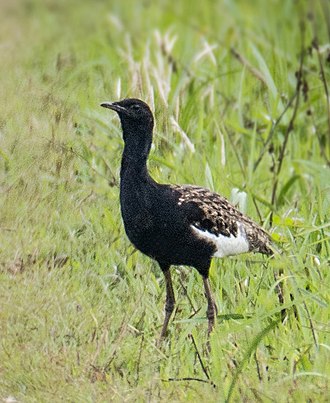India as we know is a country known for charismatic Royal Bengal Tiger, which single handedly attracts thousands of tourists to forests each year. However, India also has many other charismatic species, which are on the brink of extinction, and are yet ignored. Such is the state of India’s bustards. These are large terrestrial flightless birds that are predominantly dry grassland dwelling.
There are four species of bustards found in India, three of which are critically endangered – the Great Indian Bustard, the Lesser Florican Bengal Florican. The Macqueen’s Bustard is listed as vulnerable by the IUCN Red List.
The Four Species

Also refered to as the GIB, the Great Indian Bustards are heavy terrestrial birds, best known for their slow walking posture. The largest population of GIB is in Desert National park of Rajasthan. In Jaisalmer, GIBs are popularly known as “Godawan”. Several well reputed organisations, like the Wildlife Institute of India (WII) and Bombay Natural History Society (BNHS) are working extensively on the species. On the other hand, not much is known about the MacQueen’s Bustard. Historically, the species was found as south as Kerala. However, in India their range is now restricted to Rajasthan and parts of Gujarat.
The Lesser Florican is the smallest bustard amonst the above listed. They regularly migrate locally from southern parts of India to Madhya Pradesh, Gujarat and Rajasthan during monsoon season. Recently several sanctuaries are being set up for the protection of the bird due to its recent promotion from Endangered to Critically Endangered species. Meanwhile, the Bengal Florican is a big bustard inhabiting the terai grasslands in India and found mostly in the states of Assam and Uttar Pradesh.
What threatens India’s Bustards?
With their habitats being declared as wastelands and with their big body built, the faith of India’s bustards remains gloomy. For example, in Mandvi, Gujarat, the GIB population has crashed from 25 individuals to only 4 females due to heavy renewable energy activities in the area. Additionally, cheetah reintroduction efforts in their landscape, has resulted in the conservation resources being diverted away from bustards.
Written by: Anusua Pal
Help us Help Them! Think Wildlife Foundation is a non profit organization with various conservation initiatives. Our most prominent campaign is our Caring for Pari intiative. Pari is a rehabilitated elephant at the Wildlife SoS Hospital. 25% of the profits from our store are donated to the elephant hospital for Pari. Other than buying our wonderful merchandise, you could donate directly to our Caring For Pari fundraiser.
